We’ve all heard the debilitating platitudes like, “you’ll need to take it easier as you get old,” or “it’s all downhill after you turn 30.” How true are they when it comes to getting stronger? Is it really all-for-nothing as you age? It’s recommended that everyone engages in resistance training for various social, mental, and physiological reasons, beyond just muscle and strength¹. However today, we’ll address two key questions: Can you continue to build muscle as you age? And can you get stronger as you age? Lastly, we will highlight additional considerations for maintaining or even gaining muscle and strength into advanced age.
Ageing and building muscle
The 2010 European Working Group on Sarcopenia emphasized that muscle mass and strength are critical for quality of life. Sarcopenia, the decline in muscle mass and function, raises the risk of falls and disabilities in older adults². Research shows that resistance training can improve muscle mass in elderly individuals. For instance, in 6 to 9 weeks, a group of participants saw a 10% increase in muscle diameter. These increases affected both type 1 and type 2 muscle fibres, useful for endurance and force production. For best results, consistency matters. An average of training over 50 to 53 weeks, with three sessions per week, is effective. 2 – 3 sets of 6 – 10 reps per exercise is a great start, but people can build up to more for best results⁴. Regular resistance training is vital for maintaining daily activities. Additionally, more muscle mass can improve metabolic health, supporting well-being throughout life⁵.
Ageing and building strength
Training to emphasize strength is similar, but not the same as building muscle. For instance, training at 60% to 85% of maximum effort, taken closer to failure can build muscle. However, training at intensities of 80% and higher develops rate of force production. This is important because strength gains can occur without significant increases in muscle size due to neural adaptations. These adaptations improve coordination and muscle activation irrespective of muscle growth⁶. Since older adults can lose force production despite maintaining muscle, dedicated high intensity strength training provides unique benefits⁷. Although less volume is required compared to maximising muscle mass, 3 – 4 sessions a week with 2 – 3 sets around 80% of an individual’s maximum effort is useful for building strength. Contrary to the belief that lighter weights prevent injury, evidence shows that higher-intensity training is safe and effective⁸.
Nutrition to support muscle and strength gains
Dietary protein plays a crucial role in muscle tissue remodelling and overall health. As the systematic review published in the Journal of Cachexia, Sarcopenia and Muscle states: “Protein ingestion and resistance exercise (RE) are the main non-pharmacologic factors driving anabolic signals to increase or maintain skeletal muscle mass.”⁹ Protein itself supports cell growth, repair, and immune function. It consists of essential and non-essential amino acids. Your body can produce non-essential amino acids however you obtain essential amino acids from foods. Complete protein sources contain all essential amino acids and primarily come from animal products. Incomplete sources lack at least one essential amino acid and are often plant-based.
Most Australians meet their protein needs through a balanced diet, but specific groups may need more. These groups include pregnant women, older adults, and athletes. After exercise, consuming about 0.3 grams of protein per kilogram of body weight enhances the body’s ability to repair and build muscle. For daily intake, individuals engaging in intense training should aim for somewhere between 1.2 – 1.6 grams of protein per kilogram⁹. This equals around 112 grams for a 70 kg individual. You don’t need to start with these quantities but can gradually increase protein intake to support effective weight training and recovery.
“Old” isn’t an excuse
Old age does not prevent building muscle and gaining strength. Despite the challenges related to ageing, you can take action to reduce frailty. Research consistently shows that older adults can enhance muscle mass and strength. In fact, engaging in higher training volumes and consuming more protein will enhance results⁴, ⁹. With the right approach, older adults can combat sarcopenia and its associated risks. This ultimately enhances quality of life. By embracing a proactive attitude toward strength training and nutrition, individuals can achieve significant gains. If you’d like to prove to yourself that you’re never too old to get stronger for life, contact us today.
References:
- https://ausactive.org.au/wp-content/uploads/2022/04/AUSactive-Exercise-Guidelines-Resistance-Exercise-Prescriptions-for-Healthy-Adults.pdf
- Pathogenesis and Management of Sarcopenia – PMC (nih.gov)
- Dose–Response Relationships of Resistance Training in Healthy Old Adults: A Systematic Review and Meta-Analysis – PMC (nih.gov)
- A Systematic Review of The Effects of Different Resistance Training Volumes on Muscle Hypertrophy – PMC (nih.gov)
- Editorial: Nutritional Strategies to Promote Muscle Mass and Function Across the Health Span – PMC (nih.gov)
- Muscle hypertrophy and muscle strength: dependent or independent variables? A provocative review – PMC (nih.gov)
- https://journals.physiology.org/doi/full/10.1152/japplphysiol.00475.2016
- The Intensity and Effects of Strength Training in the Elderly – PMC (nih.gov)
- Systematic review and meta‐analysis of protein intake to support muscle mass and function in healthy adults – Nunes – 2022 – Journal of Cachexia, Sarcopenia and Muscle – Wiley Online Library
- Mechanical, hormonal, and hypertrophic adaptations to 10 weeks of eccentric and stretch-shortening cycle exercise training in old males – PubMed (nih.gov)


